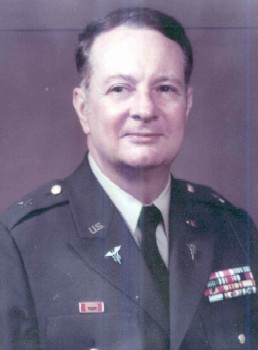


BS, Univ. Maryland, MD, 1960
MHA, Baylor Univ., Waco, TX, 1962
Ph.D., Univ. Iowa, Iowa City, IA, 1969
Chief, Army Medical Service Corps, 1977-81
Dean, Medical School, Univ. Texas Health Science Ctr., San Antonio, TX, 1989-2000
Interim Dean, Medical School, Univ. Texas Health Science Ctr., San Antonio, TX, 1988-89
Dean, School Allied Hlth. Sci., Univ. Texas Health Science Ctr., San Antonio, TX, 1987-88
Vice Chancellor, Health Aff., West Virginia Board of Regents, 1982-87
Dep. Dir. Res. Mgmt., OTSG, Washington, DC, 1976-77
Sen. Mil. Hlth. Anal., Off. Mgmt. & Budget, Washington, DC, 1973-76
Dep. Commander Admin., Silas B. Hayes hosp., Ft. Ord, CA, 1972-73
Chief, Plans & Ops. Div., Surgeon's Off., MACV, Vietnam, 1971-72
Chief, Hlth. Care Org. & Mgmt. Anal. Direct., OTSG, Washington, DC, 1969-72
Dir. Field Med. Srvc. Br., Medical Field Service School, Ft. Sam Houston, TX, 1963-66
Chief, Med. Plans & Ops., 8th Army, Korea, 1963-63
Resident, Fitzsimons Gen. Hosp., Auroa, CO, 1961-62
A native Texan, Dr. Young was born in the Lower Rio Grande Valley at Fort Ringgold, near Rio Grande City. He served in the Army's Medical Department for more than three decades, achieving the grade of Brigadier General and designation as Chief of the Medical Services Corps. Dr. Young's military career included leadership positions in large medical centers, multi-institutional health systems, corporate-level medical planning and operations, and military and civilian academic institutions. He is the recipient of the Distinguished Service Medal. Dr. Young served as vice chancellor for health affairs, West Virginia Board of Regents, before returning to Texas in the fall of 1987 to take the reins as dean of the Health Science Center's School of Allied Health Sciences. In July 1988, he was named interim dean of the Medical School. He became dean in May 1989. Since his arrival, the number of basic science and clinical faculty members has grown from 536 to 752; the Medical School operating budget has risen from $80.9 million to $177.1 million; and research and contract awards to the Health Science Center have increased from $27 million to more than $128 million.
The institution's reputation as a top-notch education and research center has grown as well. The establishment of the multidisciplinary Research Imaging Center placed the Medical School at the forefront of international brain mapping efforts. In 1995 clinical research publications from the Health Science Center ranked ninth among U.S. universities in terms of impact, according to the Institute of Scientific Information. A partnership with the Cancer Therapy and Research Center yielded a Comprehensive Cancer Center—one of only two in Texas to be designated by the National Cancer Institute. Other accomplishments include revisions to the Medical School curriculum to strengthen medical student education, integrated learning initiatives, and student exposure to bioethics and to regional health care problems. Dr. Young's other goals included bringing educational and research opportunities to underserved areas of South Texas. He was one of the driving forces behind the development of the Lower Rio Grande Valley Regional Academic Health Center (RAHC), an education, research and health promotion center along the Texas-Mexico border.